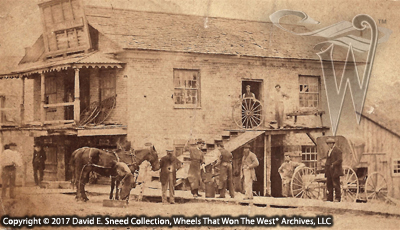Throughout the nineteenth and early halfof the twentieth centuries, millions of horse-drawn wagons were built by tensof thousands of makers in the United States. With some firms producing as many as fifty thousand to one hundredthousand vehicles per year, it’s surprising to discover just how little is leftof America’s first transportation industry. Clearly, the bulk of America’s wagons and western vehicles disappearedlong ago, whether buried, burned, rotted, or forgotten. Others are vanishing regularly as theysuccumb to the rigors of weather and lack of care. Nonetheless, even though the survivor percentages are small, there are still a numberof century-plus-old, horse-drawn wagons remaining in the U.S. Which of these are the more desirable andwhat are the reasons some will be more significant than others? Both are great questions and both have fairly involved answers.
Back in November of 2015, I wrote a piece that highlighted a number of elementsaffecting antique wagon values. At thetime, my goal was to help others see the power of individuality in different pieces. I also wanted to help folks recognize thebenefits of spending more time getting to know a particular set of wheels. Every vehicle has a specific story totell. Even so, I still receivepresumptive questions about the financial worth of an old wagon. I say ‘presumptive’ because, often, there is an assumption that a wagon should carry a certain value just because anotherone has been seen listed with that price. Too many still consider the severely limited comparisons of on-line value assessments to bethe first resource in price determinations. Truth is, the overall evaluation process canbe very involved, requiring extensive knowledge of the individual vehicle, brand,condition, originality levels, the industry, historical relevance, currentmarket trends, and more. It’s alsoimportant to know something about the anticipated purchaser. For instance, buyers of collector-grade wagonsoften have higher standards and more strict requirements than first-timeshoppers. It’s a reality that can leavesome wagons labeled as less desirable due to commonness, poor condition,construction features, or originality issues. Ultimately, determining authoritative valuesfor these antiquities is not as simple as checking out an asking price on aninternet auction service or the list price for another website that 'appears' similar. I’ve shared many times that notwo wagons are ever exactly the same. That means we must know more than the asking price of a different vehicle todetermine the actual value of a separate set of wheels. Understandingthe variances that distinguish one wagon from another can make all the difference in getting an accurate assessment.
To that point, there are countlesselements that can affect the value of an old set of wheels. One category that influenced priceback-in-the-day was the inclusion or absence of certain ‘Accessories.’ That same consideration can still hold truetoday. From the running gear(undercarriage) to the box and a host of completely separate items, there werea lot of options that an end-user could include with the purchase of awood-wheeled wagon. Even so, this is anoften-overlooked area when it comes to evaluating price differences betweensimilar-looking but still very different vehicles.
 |
| Folding end gates were not necessarily astandard item on an antique wagon. As aresult, a number of surviving farm wagons do not have this feature. |
As many items as I’ve mentioned here,there are still more features that can affect (both positively andnegatively) antique wagon values. Ittakes diligence and understanding to wade through the myriad of considerations. Reinforcing that point, let’s assume we’relooking at a pair of vehicles for sale. Both may be in similar condition but there are likely to be severaldifferences in construction characteristics. Let’s say one has taller, 52-inch rear wheels, a matching spring seat,foot board, brake, and western tire rivets. The other wagon carries a little later (newer) time frame of manufactureand does not have a seat, foot board, brake, or tire rivets. In this particular example, it’s reasonableto expect more interest to be expressed in the vehicle with the brake, rivets,etc. as it is likely to better exemplify wagons used on the westernfrontier. Oftentimes, there is a greaterpool of folks looking for that type of wagon. That said, even these vehicle differences don’t necessarily mean it’s always aslam-dunk that the higher wheeled, better-featured wagon will command a higherprice.
Since other factors like condition,originality, completeness, and documented historical provenance can also impactvalues, it’s important for both buyers and sellers to take stock of everyelement that can affect price.
 |
| Not only were rein ties usually listedas an accessory, when purchased, they could be mounted on the front end gate,on seat risers, and even on the foot board. |
Please Note: As with each of our blog writings, all imagery and text is copyrighted with All Rights Reserved. The material may not be broadcast, published, rewritten, or redistributed without prior written permission from David E. Sneed, Wheels That Won The West® Archives, LLC
